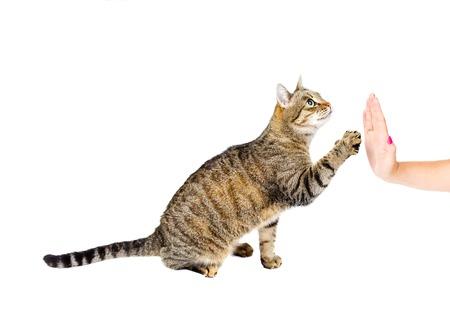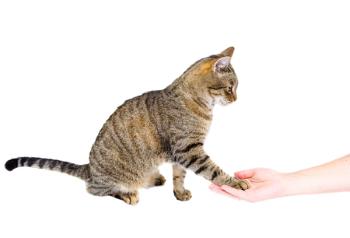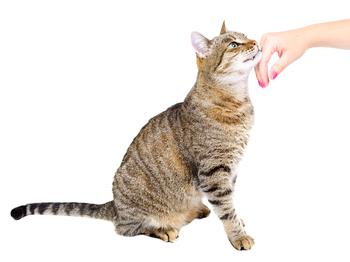Most cats have five digits on their front paws. This means they already have what it takes to give you a high five. Even though cats are not that all easy to train, we are sure you can teach your cat to give you a paw in just a few days. Here’s how to do it.

Note: For the highest effectiveness, train your cat when he or she is motivated to obtain food. Usually this is sometime before a meal is scheduled, when your cat is alert and ready for action, and definitely not right after one. If your cat has constant access to food but you want him to learn tricks, habituate him to scheduled meals.
Note 2: For your own safety, it is wise to trim your cat’s claws beforehand. This guide involves your cat attempting to retrieve a treat with his paws from your hand, which may become painful if he uses claws. Learn to trim your cat’s claws here.
- Use your cat’s favorite treats. Training without treats is like work without pay. If you want your cat to do something, there’s gotta be something in it for him. Most cats are fine with their regular dry food kibbles used as training treats. True, commercial treats, semi-moist food, or lightly cooked meat chunks might be tastier and thus more motivating. You can learn what treats to use in cat training here.
- Place a treat in your hand and show it to your cat. Since cats’ sense of smell is stronger than their vision, by “show” we actually mean “let them sniff it.” You can hold your thumb over a part of a treat, hold one between your index and middle finger, or any other way you find convenient. The trick is to keep it from falling off and keep your cat from stealing it from you. Simultaneously, he or she must be aware of it.
- Place your treat-holding hand in front of your cat. You may find that it is easier to start with a low-five position or laying your palm on the floor. If your cat is already aware of what’s in it, he may follow your palm with interest. He is also likely to touch it with his nose and rub against it. That ain’t gonna fly though; say “High five!” to your cat. Of course, you will be ignored initially, but…
 Encourage your cat to touch your palm with his paw. For many cats, it will happen automatically as they naturally reach for things with their forelimbs. However, if yours is reluctant, try to move your palm back and forth or reposition it. Place a treat on the ground. Cover half of it with your fingers, for example. Alternatively drop the treat on the ground and instantly pick it back up a few times. In a worst-case scenario, you can simply wait, although your cat might lose interest completely and walk away.
Encourage your cat to touch your palm with his paw. For many cats, it will happen automatically as they naturally reach for things with their forelimbs. However, if yours is reluctant, try to move your palm back and forth or reposition it. Place a treat on the ground. Cover half of it with your fingers, for example. Alternatively drop the treat on the ground and instantly pick it back up a few times. In a worst-case scenario, you can simply wait, although your cat might lose interest completely and walk away.
- If this happens, it’s possible that your cat is not familiar with the concept of grabbing food with his paws; the easiest solution is a food puzzle (or a DIY alternative) that requires him to do exactly that. Let your cat handle it and only then return to training. Tip: Use different cat food puzzles, toilet paper cutouts, and other means of forcing your cat “work.” They are great for mental health, they help solve boredom-related behavior problems, and they will increase your cat’s intellect, which is beneficial if you want to teach your cat cool tricks (but not so much if you want to hide your dinner from your cat).
- Praise your cat for touching your palm. Say an affirmative “Good!” and release the treat. The “good” serves as a marker to signal the cat that he did something right, and, if you say it in the same tone every single time, he will associate this “Good!” with doing the right thing and getting the food. You can achieve even better results by using a clicker. Ir produces very short click that is identical each time and occurs at EXACTLY the necessary millisecond. “Click” here if you want to know what a clicker is and how to use it in cat training.
- Repeat a few more times. Repetition is the key to knowledge, and that applies to cat training as well. Wait for your cat to consume the treat and immediately repeat the previous steps. If you did everything as described, your cat must now touch your palm sooner. Say “Good!”, release the treat, and repeat a few more times while your cat holds close to 100% focus on the task. If his attention drops less than that, take a break and resume training later.
- Gradually bring it further. After some time off (this can be a few hours or a day), you can now bring the process closer to the goal. Raise your hand just a bit higher and closer to a “proper” high five position. You can alternate and offer your cat a hand with and without a treat in it, for example. If your cat sometimes touches your hand softer than usual, with his claws drawn in, reward only these instances. The ultimate goal is for your cat to give you a high five each time you present your palm and exclaim, “Hey, Charlie, high five!” If your cat’s named Charlie, that is, because if he isn’t, saying that would be awkward.

The fun part about training high five is that in the end, you don’t have to give your cat a treat each time you high five as long as you give him one sometimes.
Giving a paw in itself is a rewarding act for your cat because it lets your cat bond with people, which many cats are desperate to do. Rub your cat’s cheeks and say “Yes, high five, good!” and you will BOTH be ecstatic.
